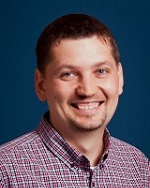Associate Professor Anton Bogdanovych

| Director of Academic Program for B. Entrepreneurship Building Virtual Reality and AI systems.Simulations of the real world – both modern and ancient – are helping us to rethink medical training and bring history to life. |
Overview
The aim of Associate Professor Bogdanovych’s research is to develop 3D visualisations and robotic systems for training, cultural reconstruction and entertainment.
His simulations create imaginary virtual environments that help people to efficiently complete practical real-world tasks in a safe, fun and highly interactive way. The ultimate aim is to make complex human activities more efficient and error-free.
The two key applications of his current work are in the areas of medical training and representing the past.
He is looking into the how Virtual Reality can be used to help medical interns acquire the necessary skills without making critical mistakes on real patients, and he is also building historical simulations that help general public with better understanding our past.
I imagine the future where most medical training happens in Virtual Reality and feels like training in the real world. In this future, doctors will be able to spend hundreds of hours of training in a fun virtual environment, where they can safely make mistakes without harming patients. I also imagine future where history lessons involve participating in a game like simulations of the past.
Impact
Associate Professor Bogdanovych’s Uruk project aims to recreate the everyday life of ancient Sumerians in one of humanity's first cities, using Virtual Reality and artificial intelligence. It won third place in the FVWC competition organised by this US Army. His Virtual Reality simulations of La Draga have been shown in museums across Spain.
His rehabilitation game for brain injury patients is being used at Liverpool Hospital and was co-designed with Kai Sakakibara (former number one Australian BMX rider). His Virtual Reality simulation for Ultrasound Guided Regional Anaesthesia has successfully finished trials with doctors at Liverpool Hospital, with very good results.
Another significant project he coordinates is Robot Tele-Operation for rescue missions, where researchers work on developing a real-time interface for controlling humanoid robots via full-body motion capture.
Why it matters
Associate Professor Bogdanovych’s research has applications for history, health, psychology, anthropology and archaeology.
His simulations can potentially be used by universities, museums and hospitals for training and to reinvent how we preserve our history to better understand our past, present and future.
Career
From 2011, Associate Professor Bogdanovych has been a full-time lecturer of Entertainment Computing and Applied Artificial Intelligence at Western Sydney University, School of Computing, Engineering and Mathematics. At the University he teaches "Video Game Development", "Human Computer Interaction" and "Advanced Topics in ICT". He also works as a casual lecturer at UTS, where he teaches "Intelligent Agents" and "e-Market Trading Technology".
From October 2007 to December 2010, he was employed as a Postdoctoral Research Fellow at Western Sydney University, where he actively participated in the ARC Discovery grant `It's all about me' – Anthropomorphized Trading in Believable Electronic Markets, where the findings of his PhD work played the key role.
He completed his PhD degree at the faculty of Information Technology, UTS, in May 2008 with the thesis "Virtual Institutions". This thesis laid the foundations for research on normative regulation of virtual worlds and initiated collaborations with a number of research organisations across the globe.
Before starting his PhD at UTS, he worked as a researcher and software developer in the Multiagent Systems department in the German Research Centre for Artificial Intelligence (DFKI). DFKI is one of the largest and most prestigious Artificial Intelligence research centres in the world. He was involved in European Union-funded projects related to building an intelligent agent-based recommender system for elderly digital TV users (SAID), as well as developed algorithms for path classification and persona categorisation for mobile device users (SPECTER).
His industry experience with Software MacKiev (the largest company that produces Macintosh versions of famous Windows titles) has helped him to become familiar with programming methodologies, tools and people management techniques employed for producing outstanding software titles. One of his products (WorldBook Encyclopaedia) was preinstalled on every iMac computer sold in 2001.
Research Interests
- Virtual Reality
- Artificial Intelligence
- Motion Capture
- Robotics
Qualifications and Honours
- PhD in Computer Science from University of Technology Sydney, 2008
- Specialist degree in Computer Science, International Solomon University, 2000
Roles
- Lecturer in Entertainment Computing and Applied Artificial Intelligence
- Coordinator of the Human-Machine Interaction Research Program
Notable Achievements
- Published a book for general audiences titled: “Learning Java Programming in Clara’s World in 2021
- Organiser of the 25th ACM Symposium on Virtual Reality Software and Technology (VRST), 2019
- Organiser of the 18th Intelligent Virtual Agents Conference 2018 conference (IVA), 2018
- International Educator of the Year Award winner by The South East Asia Regional Computer Confederation (SEARCC), 2016
- GALA 2016 Best Demo Video Award Issued by Intelligent Virtual Agents Conference · Sep 2016
- 2015 Australian ICT Higher Education Educator of the Year Award winner by the Australian Computer Society (ACS)
Collaboration
Associate Professor Bogdanovych sees the best part of his job as working with interdisciplinary teams, where 3D visualisations help everyone to understand each other, collaborate productively and produce unique knowledge and systems that they would not be able to create alone.
3D visualisations are great for collaboration. The team usually starts with listening to all the partners, collecting their requirements and producing a game design document that explains what will be produced. This document is revised through many iterations and gets refined as various collaborators better understand the project and requirements of all partners.
Connect
| a.bogdanovych@westernsydney.edu.au | |
| Phone | +61 2 9685 9180 |
| Location | Western Sydney University Parramatta campus |
| Room | ER.1.14 |






